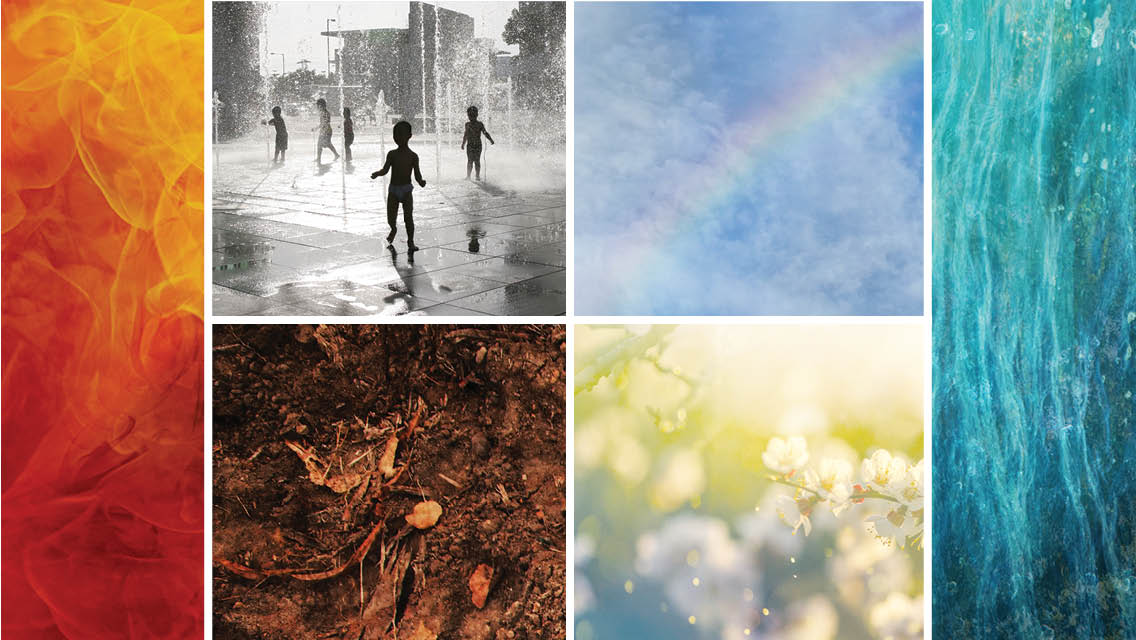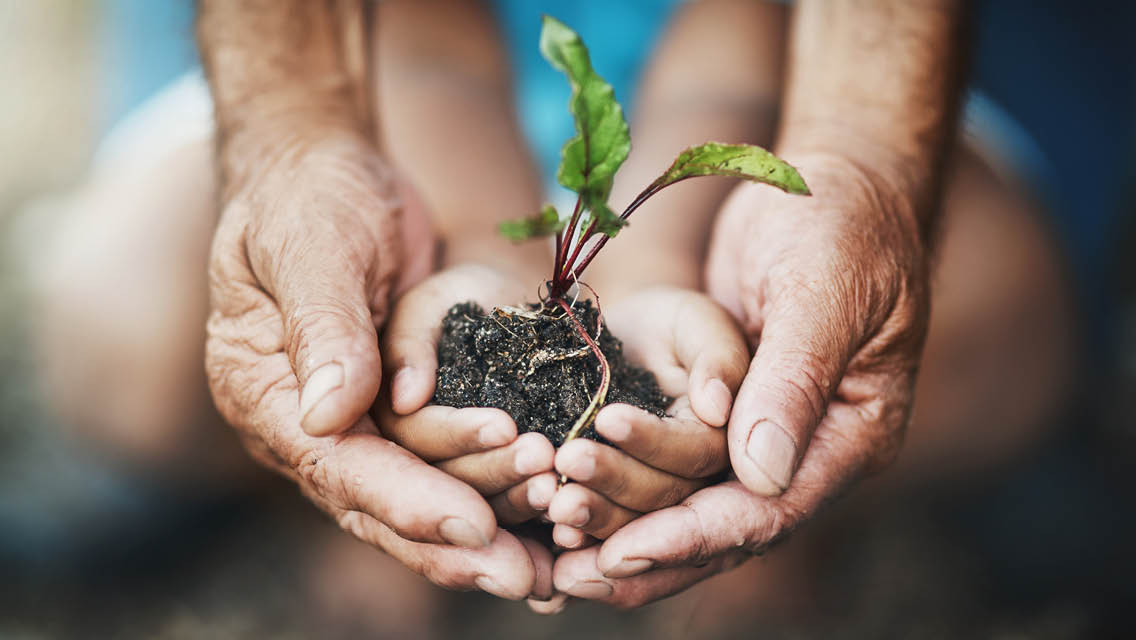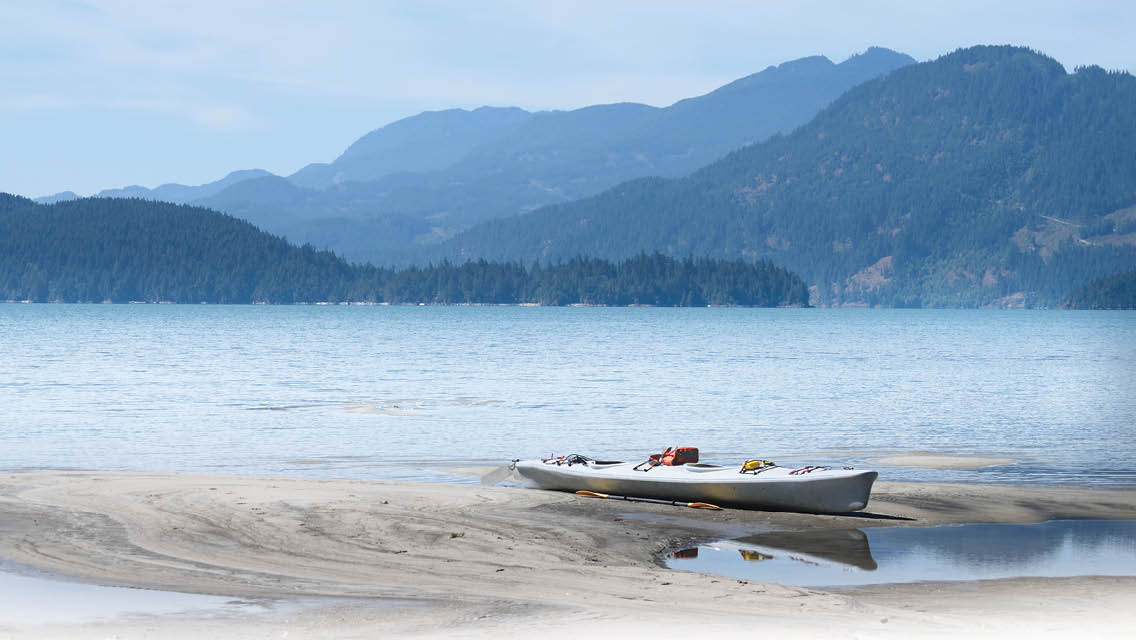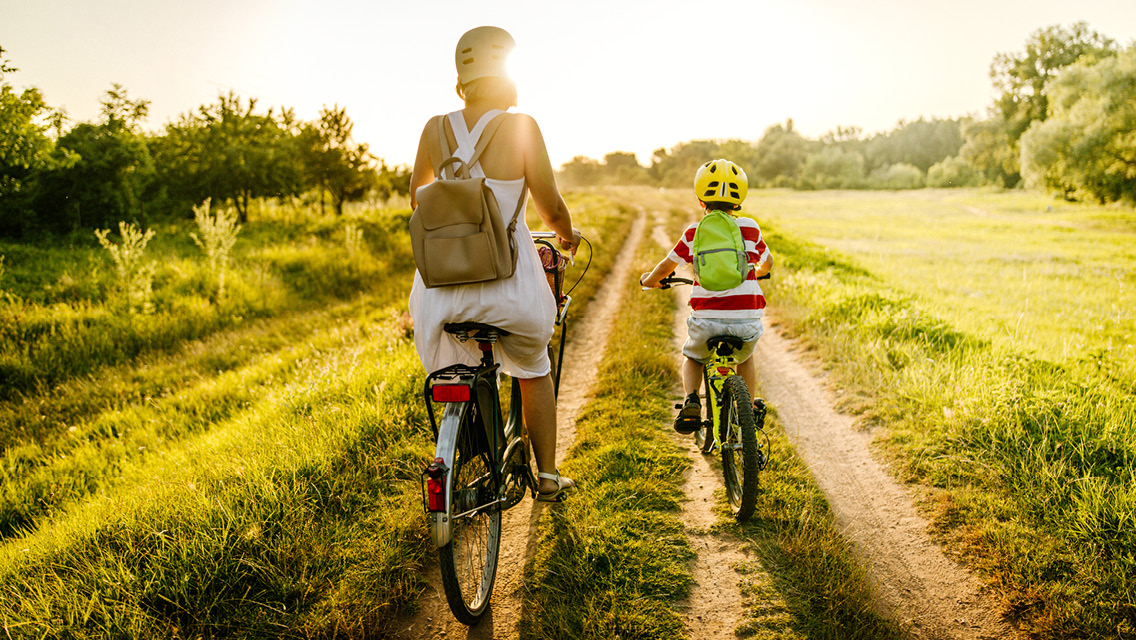Sections in this article: ⋅
Air Pollution ⋅ Allergens and Pollen ⋅ Vector-Borne Diseases ⋅ Temperature Extremes ⋅ Focus on What You Can Do ⋅ Eat a Climate-Friendly Diet
In 2015, the Lancet Commission on Health and Climate Change declared that tackling the climate crisis could be the greatest global-health opportunity of the 21st century. That’s because unchecked climate change and associated trends, such as waning biodiversity, represent some of the greatest known threats to human health.
“We generally characterize four main environmental drivers from which adverse health effects might originate: rising temperature, extreme weather events, rising sea level, and increased atmospheric carbon dioxide,” says professor of emergency medicine Jay Lemery, MD, FACEP, FAWM, codirector of the Climate and Health Program at the University of Colorado School of Medicine and coauthor of Enviromedics: The Impact of Climate Change on Human Health.
Some experts predict that for the next few decades, the main health effect of climate change will be the worsening of preexisting health conditions. For instance, people suffering from asthma may be susceptible to more frequent or more severe attacks. Increased heat and humidity causes air to stagnate, which increases our exposure to particle pollution that irritates the lungs.
As time goes on, though, these experts expect climate change will result in more unhealthy people overall, because of more extreme temperatures, harmful exposures, and environmental degradation.
There are some hopeful developments. The Inflation Reduction Act, signed into law by President Biden in August 2022, is expected to cut roughly a billion tons of greenhouse-gas emissions a year by 2030. It allocates funds for soil-enrichment programs and other efforts to increase climate-friendly agriculture, and it boosts tax credits for capturing and storing carbon dioxide.
“All of us in the climate-and-health world are very pleased that something’s being done,” says Lemery. “It feels like a multipronged approach that I’m hopeful we can continue to build on.”
Still, we have a long way to go to protect the planet and ourselves. It’s worthwhile to take stock of the health challenges the changing climate will present — and learn how to build more resilience for ourselves and our communities. Here are some of those challenges and ways to address them.
1) Air Pollution
The average person inhales roughly 20,000 times each day, making breathing the most fundamental way we interact with our environment. Today, many of those breaths include pollutants, such as particulates, carbon monoxide, nitrogen oxides, and sulfur dioxides, created by human industrial activities as well as by wildfires and volcanoes. These compounds can cause acute respiratory symptoms and heart disease, among other problems.
The American Lung Association stated in its 2022 State of the Air report that more than 40 percent of Americans, some 137 million people, live in places with unhealthy levels of ozone or particle pollution.
According to the Centers for Disease Control and Prevention (CDC), about 8 percent of the U.S. population has been diagnosed with asthma. Between 1980 and 2002, the total number of cases more than doubled.
Wildfires, which are increasing in frequency and severity and often exacerbated by drought, are one of the leading causes of worsening air quality. “Wildfires don’t need to be that big to degrade air quality over huge swaths of land,” Lemery notes. (See “The Ecological Consequences of Wildfires” for more.)
“Here in Denver, we have triathletes coming in after working out, thinking they have asthma, but it’s actually reactive-airway disease from smoke from wildfires.”
Poor air quality affects not only the physiologically vulnerable but also the young and healthy. “Here in Denver, we have triathletes coming in after working out, thinking they have asthma, but it’s actually reactive-airway disease from smoke from wildfires,” he says. “It affects everybody.”
Increased heat and atmospheric temperatures worsen the effects of air pollution, he adds. A recent University of Southern California study assessed the correlation between air quality, temperature, and mortality in Southern California. It found that extreme-heat days carried a 6.1 percent increase in overall mortality risk. On extreme-air-pollution days, the risk increased by 5 percent. On days with both extreme heat and extreme air pollution, deaths were 21 percent more likely. Those over age 75 faced the greatest increase in risk.
How to Build Resilience
Those who live in areas prone to drifting smoke from wildfires (that’s almost all of us) should be familiar with the daily air-quality index, Lemery says. Before heading out for a jog, assess whether it’s going to be a healthy day to exercise outside. If not, find a way to keep your workout indoors, preferably somewhere with an air filter.
“Having a good HEPA air filter that filters out very small particles is becoming a requirement for people who live in areas impacted by forest fires. For extra-fine smoke particles, it may be necessary to combine the HEPA filter with one that has a chemical absorbent, such as activated charcoal,” says integrative practitioner Robert Rountree, MD.
In addition to filtering out the bad stuff, it’s important to nurture healthy lungs from the inside out by spending time in nature — when air quality allows, he says. “We used to think that outside of the skin, nose, and gastrointestinal tract, the body was pretty sterile. Now we know that we also have a lung microbiome with its own unique community of healthy bacteria.”
A healthy lung microbiome is crucial to avoid “leaky-lung syndrome,” a loosening of the tight junctions in the lining of the lungs, which occurs when they’re chronically irritated by smoke or other particulate matter. Leaky lungs allow bacteria and other substances to get into the space beneath the surface of the lung, activating the immune cells there. This triggers a chronic inflammatory response — the first stage of autoimmunity.
Rountree recommends walking regularly in green and blue spaces to support a healthy lung microbiome. “When you walk by the ocean or a lake where the air is full of moisture, you’re breathing in tens of thousands of viruses and bacteria — all that wet air is replenishing your lung microbiome.”
And walking in the woods or practicing shinrin-yoku (forest bathing) exposes your lungs to phytoncides, beneficial volatile organic compounds that have been shown to offer anti-inflammatory, mood-supporting, and immune-enhancing benefits. “Even if you just go for a 30-minute hike in a wooded area and breathe deeply, that helps restore the lung microbiome,” Rountree says.
(Learn more about lung health at “Take a Deep Breath.”)
2) Allergens and Pollen
Allergies are among the most common medical conditions in the world. In the United States alone, more than 50 million people suffer from allergies each year.
Seasonal-allergy symptoms — such as red, itchy eyes; runny nose; sneezing; and cough — are rarely life threatening, but they can cause plenty of suffering. “Pollen is one of the things that isn’t going to kill you, but it has tremendous health consequences in terms of lost days at work or people buying cold medicines because they’re so miserable,” Lemery says.
The growing amount of carbon dioxide in the air, combined with warmer temperatures and longer growing seasons, means we can expect a greater burden of seasonal allergies in many parts of the world.
The growing amount of carbon dioxide in the air, combined with warmer temperatures and longer growing seasons, means we can expect a greater burden of seasonal allergies in many parts of the world.
“Remember, carbon dioxide is like plant food,” Lemery notes. “We’re already seeing increases in ragweed and pollen and a longer pollen season in northern latitudes.”
How to Build Resilience
Although allergies may seem like a seasonal inevitability, there are nonpharmaceutical tools that can help us manage their effects.
“The allergic response in humans is an immune-system response,” says Mary Purdy, MS, RDN, an integrative nutritionist and eco-dietitian in Seattle. “It can often be a result of the immune system being on some kind of high-alert status.”
She suggests addressing the health of the gut as one avenue for calming this state of alarm. The immune response is usually “directly related to the status of the gut microbiome; approximately 70 percent of the immune system resides there,” she says.
Reducing the body’s inflammatory response is also key. “Brightly colored fruits and vegetables, herbs, and spices all contain compounds that reduce inflammation and help the body’s immune response be less reactive,” Purdy says.
A plant-heavy diet, rich in diverse fiber and phytochemicals from a wide variety of foods, can also help nurture the gut microbiome in an immune-supporting way.
When allergies do strike, Purdy says, try supplements with plant-derived antihistamine combinations, such as quercetin (also found in apples and onions), stinging nettle, bromelain (found in pineapple), and vitamin C (found in citrus, red peppers, and broccoli). (Read more about quercetin and other sources of allergy relief at “Can Quercetin Relieve Your Season Allergies?“)
And although the research is mixed, some studies suggest that eating raw, local honey can benefit people with seasonal allergies, because it’s likely to contain pollen from the same area. The idea is that regularly exposing the body to small amounts of an allergen can help desensitize the immune system.
Increasing your body’s production of the antioxidant glutathione might also mitigate reactions that affect the lungs, including asthma. Sulfur-rich foods, such as garlic, onion, and broccoli, boost glutathione production in the body, or you can take a glutathione-supporting supplement, such as N-acetylcysteine. (Find out more about allergies at ”Taking On the Allergy Epidemic.”)
3) Vector-Borne Diseases
Ticks, mosquitoes, and fleas have long served as vectors that can transmit pathogens to humans. Some of the best-known vector-borne diseases around the world include malaria, dengue, chikungunya, yellow fever, and Zika. (Evidence suggests the virus causing COVID-19 likely jumped to humans from an animal host.)
In the United States, the list also includes Lyme disease (caused by Borrelia burgdorferi or Borrelia mayonii, types of bacteria carried by black-legged ticks) and West Nile virus (transmitted by mosquitoes).
More than half of all the infections that people can get are zoonotic, meaning they go from animals to people.
“According to the CDC, more than half of all the infections that people can get are zoonotic, meaning they go from animals to people,” says Rountree. Changing weather patterns, expanding human development, and waning biodiversity all increase the odds that more of us will encounter these kinds of infections more often.
“The risk of Lyme disease is going to go higher and higher because of degraded habitats,” he explains. “In a healthy habitat, you have a lot of natural predators that feed on the mice that carry the ticks that transmit Lyme. When you fragment the forest, you lose those predators and the mice become more prevalent. Then you go for a fun hike and boom, you get exposed to Lyme and other tick-borne diseases.”
Higher temperatures are expanding the range where disease-carrying mosquitoes and ticks can live and reproduce. “Where winters have historically been protective, vectors are now able to hang around longer, reproduce longer, and spread disease longer,” Lemery says. “Diseases that have long been the domain of tropical and subtropical areas are moving slowly into higher latitudes and altitudes.”
How to Build Resilience
Prevention is the best strategy when addressing vector-borne diseases. “Since black-legged ticks are the main carriers of the bacteria that cause Lyme and related diseases, the best way to prevent Lyme is not to get bitten in the first place,” says Rountree.
He notes that this can be challenging: The biggest offenders are small, immature ticks called nymphs, less than 2 millimeters in size and hard to see. He emphasizes the importance of using good bug repellents and conducting a thorough skin check after hiking. When you’re in tick-friendly habitats, such as dense woods, forests, and prairies with tall grass, wear some tick-protective clothing. (For more tips on avoiding ticks, see “Lyme Disease: How to Protect Yourself This Summer.“)
Vaccines may also play an increasing role in fighting zoonotic infections. A new malaria vaccine, developed by scientists at the University of Oxford, was recently found to be up to 80 percent effective in clinical trials; it is expected to be rolled out across sub-Saharan Africa this year.
A vaccine against Lyme disease is currently in stage 3 clinical trials, and a monoclonal-antibody treatment for the disease is also in the works.
Still, the growing range of Lyme-prone areas means that more healthcare providers need to learn how to recognize and treat it, Lemery says. “Lyme is an insidious disease — a great mimicker that can hide below the surface. We’ll need to recalibrate our healthcare systems to be ready to treat these types of diseases that maybe historically haven’t been an issue.” (Learn more about new treatments for Lyme at “A New Look at Chronic Lyme.”)
Following an overall immune-supportive diet and lifestyle remains important on the individual level, too. Maintain a vitamin D status in a functional range (50–80 ng/mL) and ensure you’re getting enough zinc, omega-3 fatty acids, and vitamins A and C. These help the body fight infections and, crucially, resolve them, Purdy says. (To learn how to make your meals more immune supportive and climate friendly, see “Eat a Climate-Friendly Diet” further down.)
“Your body needs the team of soldiers to fight the infection, but also the team of architects and construction workers to rebuild and maintain the integrity of the immune system so it’s ready for the next infection it comes across,” Purdy says. “So often we’re stuck with this immune system on high alert, and we need some of those food compounds to help calm it down again.” (Find out how to support the immune system at “How Chronic Inflammation Affects Your Health.”)
4) Temperature Extremes
Think of the range of normal temperatures in any given region as a bell curve. Most weather events happen within the big part of the bell, and rare events (extreme temperatures, droughts, heavy rain, etc.) fall at the tail ends. Or they used to.
As the climate changes, the curve is shifting to the right (toward higher temperatures) and flattening, meaning that extreme events are becoming more common.
“Heat is energy. We’re adding energy to our weather system, so the range of crazy weather is increasing,” Lemery explains. There might be brief periods of extreme cold in places that haven’t seen it before, as with the polar vortex that pushed frigid air into Texas in February 2021.
But the general trend is toward heat. “We’re energizing our weather systems in a way that makes everything more unpredictable,” he says. “And on average, it’s warmer.”
Heat is a stressor for the human body, particularly for the very old, the very young, and those without access to heat-diffusing green spaces or air conditioning.
Heat is a stressor for the human body, particularly for the very old, the very young, and those without access to heat-diffusing green spaces or air conditioning. It can exacerbate existing health issues, such as cardiovascular and respiratory diseases. Studies have shown that for every incremental increase in heat (about 1.8 degrees F), the death rate for people with comorbidities, such as chronic obstructive pulmonary disease, heart disease, and diabetes, also goes up.
“If you’re walking across a big parking lot on a hot summer day, your pulse will go up by 20 beats per minute and you’ll start sweating,” Lemery says. “Your body has this compensatory mechanism to cool you off, but that physiologic stress alone can be enough to push somebody who’s medically vulnerable into crisis.”
Yet it’s not solely vulnerable groups who are affected by extreme heat. Anybody can experience the muscle cramps, swelling, heat exhaustion, and heat stroke that hot temperatures can cause. High temperatures have also been linked to poor mental health and higher rates of aggression.
How to Build Resilience
When extreme heat strikes, Lemery says, it’s important to slow down and be mindful of the risks. “In a heat wave, it’s about not going out and doing yard work or exercising in the middle of the day; it’s about drinking a lot more water and staying cool.”
Hydration is critically important in high temperatures or at high altitudes, and Rountree says that water is usually your best option. “Something I’ve learned from 40 years of hiking in Colorado is that it is better to hydrate long before you get thirsty.”
Countertop water filters are inexpensive and effective at removing unwanted toxins and chemicals from tap water. They can also help improve taste, so hydrating is more appealing.
Electrolyte drinks with added sodium, potassium, and magnesium (all minerals we lose through sweat) can be helpful after an intense workout on a hot day, or if you notice symptoms of an electrolyte imbalance, such as muscle twitching and cramps, increased thirst, poor endurance, salt cravings, and irritability. (Make your own with this recipe.)
Unsweetened coconut water is naturally rich in electrolytes and low in sugar. Rountree also likes watermelon juice: “It’s a great source of lots of nutrients and is an excellent way to get hydrated since it is rich in potassium.”
One of the most important things to do during a heat wave is to check in on your neighbors, Lemery says. “It’s the elderly who you really need to look out for, especially those who live by themselves.”
He suggests learning to think of ourselves as community-safety officers. Learn the locations of the closest cooling centers and public areas with air conditioning, such as libraries or shopping malls — and make sure your neighbors know about them. “This is where social interaction is really important to keep people safe,” Lemery adds.
Focus on What You Can Do
The reality of a changing climate can be overwhelming. To sustain your mental health in the face of climate stress, Lemery says, consider reducing news consumption. “Staring at the TV or doomscrolling on Twitter doesn’t help. Those are just anxiety machines.”
Instead, he suggests viewing our present climate situation through the lens of history, noting that we have been able to address many horrible diseases and health crises thanks to medical innovations like the polio vaccine and the development of antibiotics. “If we can look back and borrow the confidence of our forebears, we can say, ‘They did it, and we can do it, too.’”
Finally, action is the best antidote to despair. Rountree suggests looking for ways to make a difference in your own life, community, and profession. Identify waste or environmental harm occurring in your sphere of influence, and work to change it. Vote for politicians who support sound climate policies. Join or donate to organizations working to address climate change.
And, most important, cultivate your own relationship with the planet. “Get out into nature and appreciate what we have now,” he says. “Take time to connect with nature and then find ways to become an advocate.”
Eat a Climate-Friendly Diet
We know that our food choices affect our individual health; they also matter to the health of the planet.
Happily, an immune-supportive diet shares many features with a climate-friendly one: They’re both plant-heavy and diverse, with an emphasis on local, seasonal, sustainably produced foods. “A climate-friendly diet involves foods that have a lower environmental footprint, use fewer resources, create fewer greenhouse-gas emissions, and help build health back into the ecosystem,” says integrative nutritionist Mary Purdy, MS, RDN.
Growing plants requires fewer resources, including land and water, than raising farm animals. Red meat and dairy are the biggest culprits in terms of greenhouse-gas emissions, Purdy says.
Meat eaters can make environmentally sound choices by emphasizing lower-impact animal-protein sources — eggs, chicken, fish — in addition to upping their quantity of plants.
Opting for regeneratively raised meat can also have a net benefit for soil health, because these systems incorporate animals into farming practices in a symbiotic way. (Find out more about regenerative farming at “Can Regenerative Agriculture Save Us?“)
Variety is also key. “The more diverse a diet is, the more we’re supporting biodiversity, which is what creates more resilience in the face of climate change,” Purdy notes. “When we’re faced with drought, floods, or extreme weather patterns, our food system is more resilient if there are numerous crops being grown, numerous microorganisms in the soil, and numerous plants and animals in existence.”
The variety of foods we consume also has a direct impact on the ecosystem of the gut microbiome, she notes. “A more diverse gut microbiome has been correlated with health benefits, a more resilient immune system, and a better ability to digest and absorb nutrients.”
This article originally appeared as “Adapt to Change” in the April 2023 issue of Experience Life.





This Post Has 0 Comments